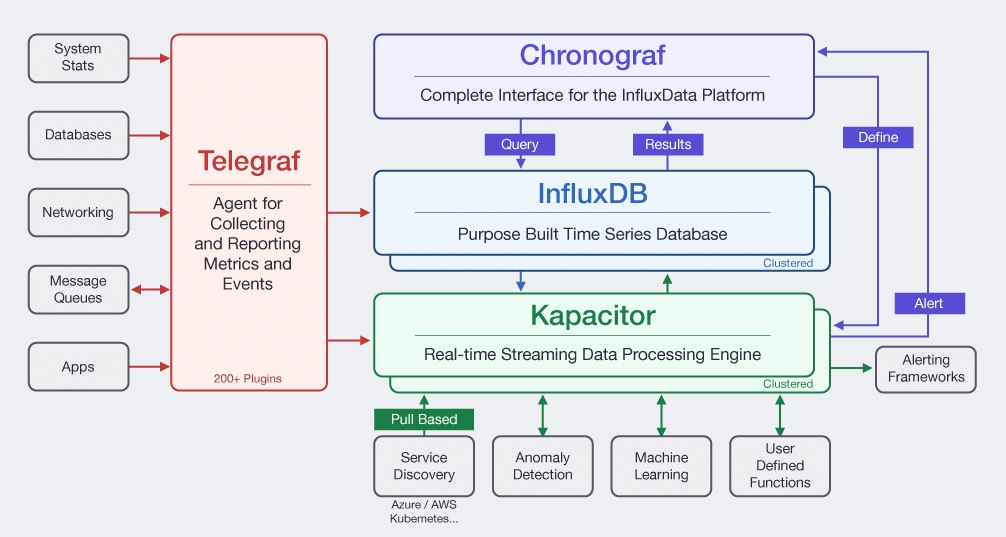This is the first in what will become an ongoing series of client profiles, where we explore some of the interesting things our clients are up to.
About InfluxData
Founded in 2013, InfluxData is a platform for time series data. There are a growing number of use cases for timestamped data, including infrastructure monitoring, IoT device management, and real-time analytics. The InfluxData platform helps companies store and manage these timestamped metrics and events.
You can read more details about the characteristics of time series data in my analysis on The State of the Time Series Database Market, but at a high level:
- Once created, the data tends to be immutable. Point-in-time measurements are generally not changed, and new data is appended to the data set rather than revising previous data.
- Time series data sets are designed to track changes over time, but not all time periods are of equal importance. More recent data is typically the most useful and actionable, whereas the granular details of older data may be less relevant.
- The data tends to be high volume.
While InfluxDB is the heart of the platform, InfluxData offers a stack of projects designed to help with not only storage but also the data collection, visualization, and stream processing of time series data.
In addition to OSS, you can also use Influx platform as a managed cloud service or an on-prem enterprise offering. The company follows an open core model, so the paid versions of the product offer additional functionality like clustering that is not readily available in the open source components.
Competitive Landscape
The competitive landscape around time series databases is fairly dynamic, especially because competition is not confined to that database category. Time series databases are one of many options for storing and ingesting timestamped data.
- For data that needs to be persisted, general purpose databases can be used for storing time series data. Columnar databases like Cassandra, search databases like Elasticsearch, and scalable relational databases like PostgreSQL can handle time series data.
- For some use cases (particularly in the IoT realm), a streaming architecture with a real-time dashboard is sufficient.
- For infrastructure management use cases, specific tooling around logging, monitoring, and observability are also viable considerations (especially when considering that some of these tools are better suited to handling high-cardinality data than a time series database.)
There are a variety of open source and proprietary time series databases currently on the market, and at 2018 re:Invent, Amazon Web Services (AWS) announced a managed service time series database Timestream that is currently in preview.
Context
InfluxData currently sits in the middle of some interesting trends in the industry. Two that are of particular interest are the current tensions between cloud and commercial open source companies, and the expanding discussions around system observability.
Cloud and Open Source
Commercial open source database providers and cloud providers have had a tumultuous recent relationship. As co-mingled source code and “non-compete” licenses have been answered with alternative distributions of open source projects, tensions between these communities are, to put it mildly, strained.
While InfluxData has largely stayed out of the fray, it’s worth noting the company is operating against this backdrop, especially as InfluxData becomes a managed service with Google later this year and when AWS launches Timestream.
Observability
As companies turn to microservices in search of increased development velocity they encounter increased complexity in understanding and observing their system. As these distributed architectures become increasingly prevalent, the need for increased visibility into infrastructure will grow and the tooling to support those efforts will become increasingly important. There are numerous potential approaches to handling this category of data, and the market around monitoring and observability tools is fragmented and competitive.
Related Posts
- Rachel Stephens, The State of the Time Series Database Market
- Steve O’Grady, Where the Database Market Goes From Here
- Steve O’Grady, The Cloud and the Open Source Powder Keg
Disclaimer: As you may have ascertained from the title, InfluxData is now a RedMonk customer. Elastic, AWS, and Google are also RedMonk customers.

Donnie Berkholz says:
April 27, 2019 at 9:43 pm
I feel like this would be a really great addition to the RedMonk research portfolio if you broadened the scope to all briefings (with some sort of value filter) vs client-only — maybe starting with clients and then opening things up. It’s got some parallels to one of the 451 publication formats.